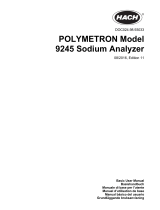Page is loading ...

General instruction for DO electrode
Instrucciones generales para electrodos DO
Instructions générales pour
les électrodes OD
Ohaus Corporation
7 Campus Drive
Suite 310
Parsippany, NJ 07054 USA
Tel: (973) 377-9000
Fax: (973) 944-7177
With offices worldwide
Con oficinas en todo el mundo
Avec des bureaux dans le monde entier
www.ohaus.com; [email protected]
*30031637*
P/N 30031637 B © 2015
Ohaus Corporation, all rights reserved/ todos
los derechos reservados/ tous droits réservés

STDO11 EN-1
Model
Item NO
Description
STDO11
30031639
Galvanic DO electrode
Specifications:
Connection: BNC
Cable length: 1.1m
Shaft length: 120mm
Shaft diameter: 12mm
Shaft material: Plastic
Temperature range: 0-50℃
Measurement range: 0-200%
Storage Solution: 10% NaCl
DO electrode is to measure the Dissolved
Oxygen in the water. Galvanic DO electrode
does not need to warm up before
measurement. It can reach 95% of the final
reading after 1 minute measurement.
If you want to measure the temperature at
the same time, you can purchase
temperature electrode STTEMP30
(83033970).

EN-2 STDO11
DO electrode operation:
1. Unpacking
Carefully remove the protective bottle from
the tip of the electrode by unscrewing the lid
then removing the bottle. Remove the
shorting plug from the connector and store in
a safe place. Be careful because the
protective bottle lid is tightly fit on the
electrode.
2. Calibration
Connect the electrode to the instrument, rinse
with deionized water and carefully dry the tip
of the electrode with a tissue. Then follow
your instrument instruction manual for
detailed calibration.
After calibration and measurement, you
should rinse the DO electrode then storage in
the protective bottle.

STDO11 EN-3
FAQ:
1. DO electrode condition
Electrode condition icon give you an intuitive
information about the DO electrode
performance.
Slope: 80-125%
Electrode condition is good
Slope: 60-80%
Electrode condition is not good, may need
cleaning or replace
2. Cleaning
This galvanic oxygen electrode has no
customer serviceable parts. Cleaning is
important however, and the electrode should
be rinsed thoroughly in pure water between
and after measurements. NEVER allow the
sample to dry on the electrode.
If dirt or sample do dry onto the membrane,
the tip of the sensor can be immersed in pure
water and ultrasonically cleaned for 30
seconds.
3. Storage
After rinsing the electrode, refit the storage
bottle and shorting plug and store in a cool
dry place.

STDO11 FR-3
QUESTIONS FRÉQUENTES :
1. État de l'électrode OD
L'icône d'état de l'électrode fournit des
informations intuitives sur les performances
de l'électrode OD.
Pente : 80-125 %
L'état de l'électrode est bon
Pente : 60-80 %
L'état de l'électrode n'est pas bon et peut
nécessiter un nettoyage ou son
remplacement
2. Nettoyage
L'électrode à oxygène galvanique ne contient
aucune pièce réparable par le client. Le
nettoyage reste néanmoins important et
l'électrode doit être rincée abondamment
dans de l'eau pure, entre et après les
mesures. NE JAMAIS LAISSER l'échantillon
sécher sur l'électrode.
Si des saletés ou l'échantillon sèchent sur la
membrane, l'extrémité du capteur peut être
immergée dans de l'eau pure et nettoyée aux
ultrasons pendant 30 secondes.
3. Rangement
Après avoir rincé l'électrode, repréparer la
bouteille de stockage et la fiche de court-
circuit avant de les ranger dans un lieu frais
et sec.
/







